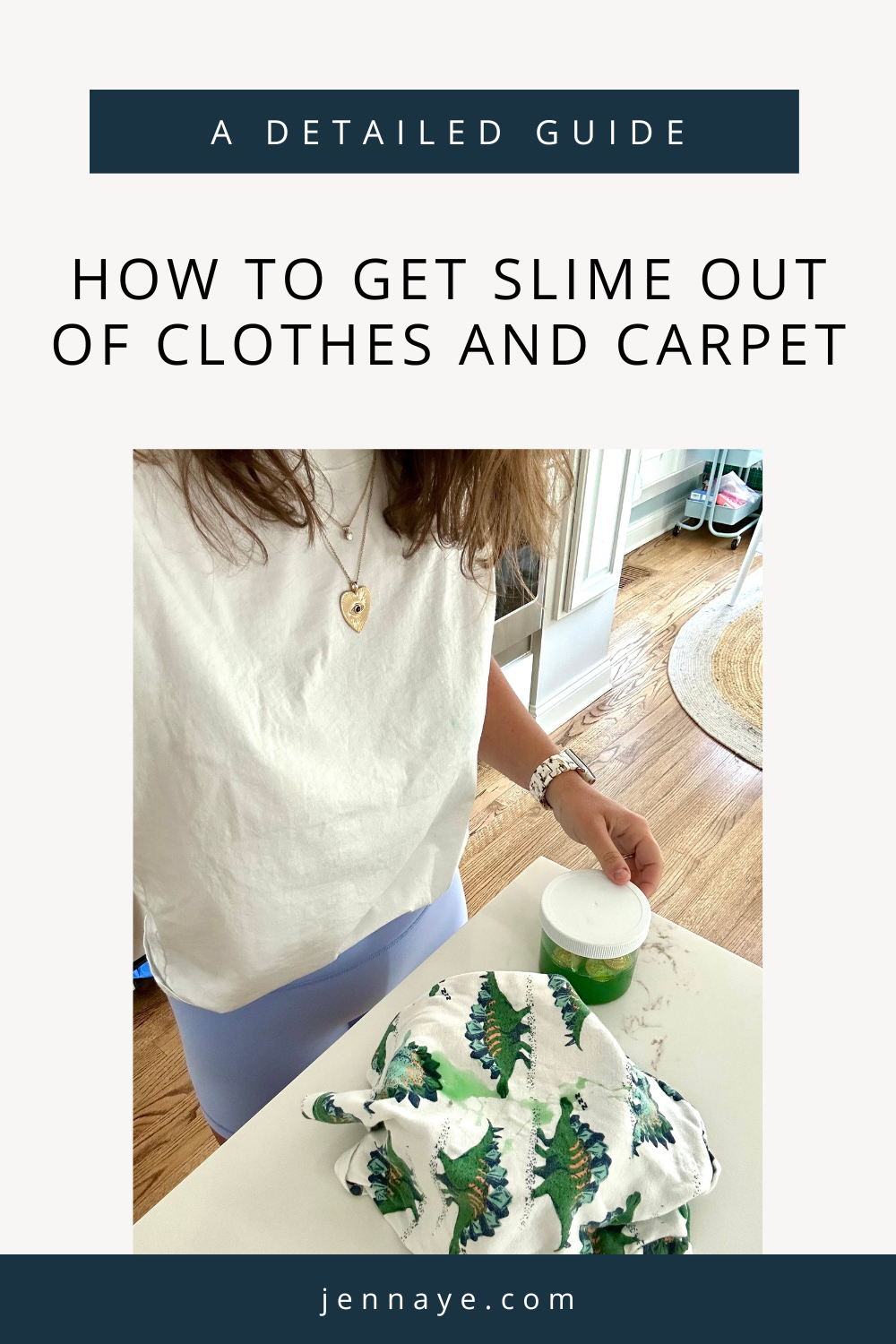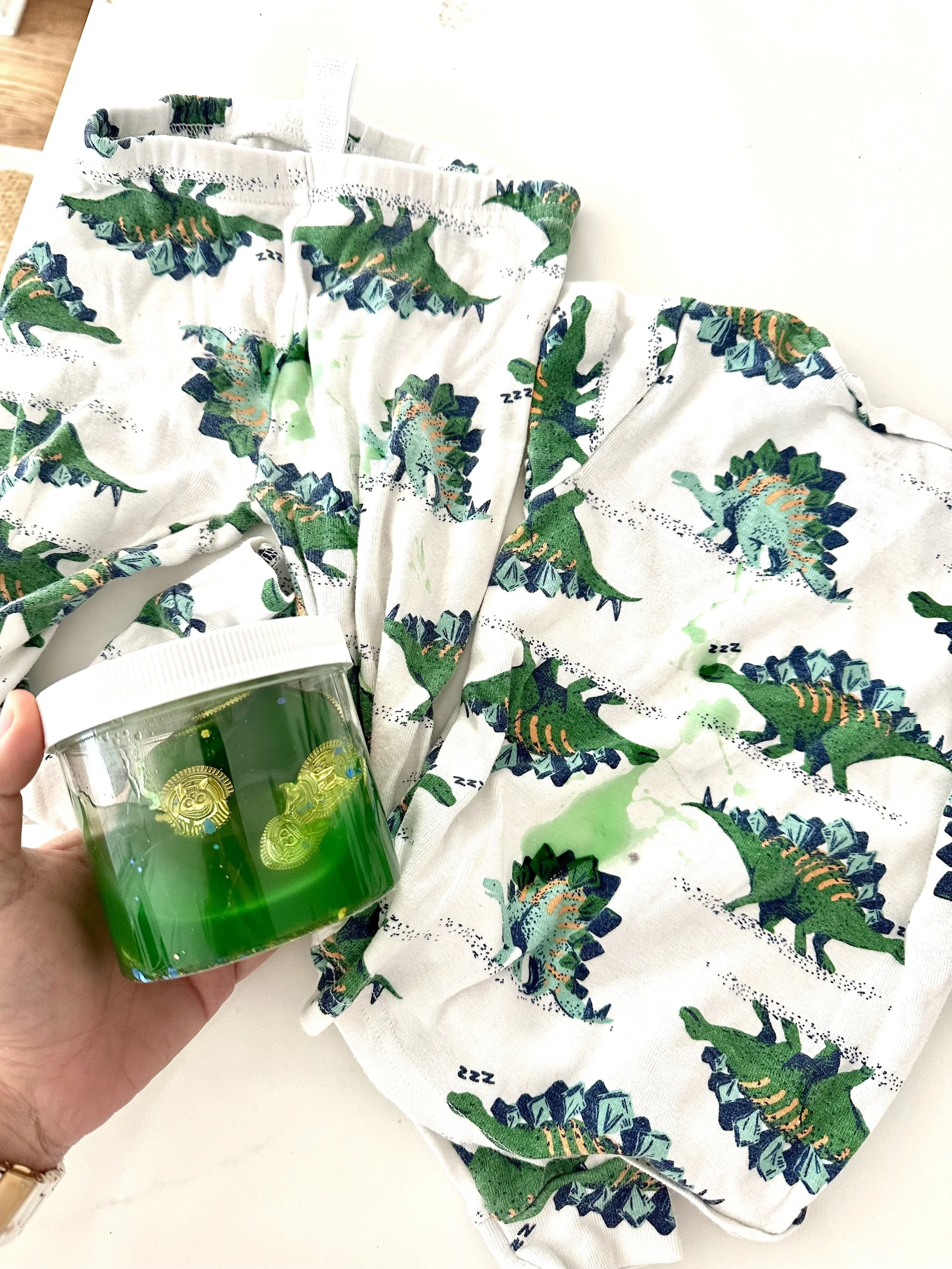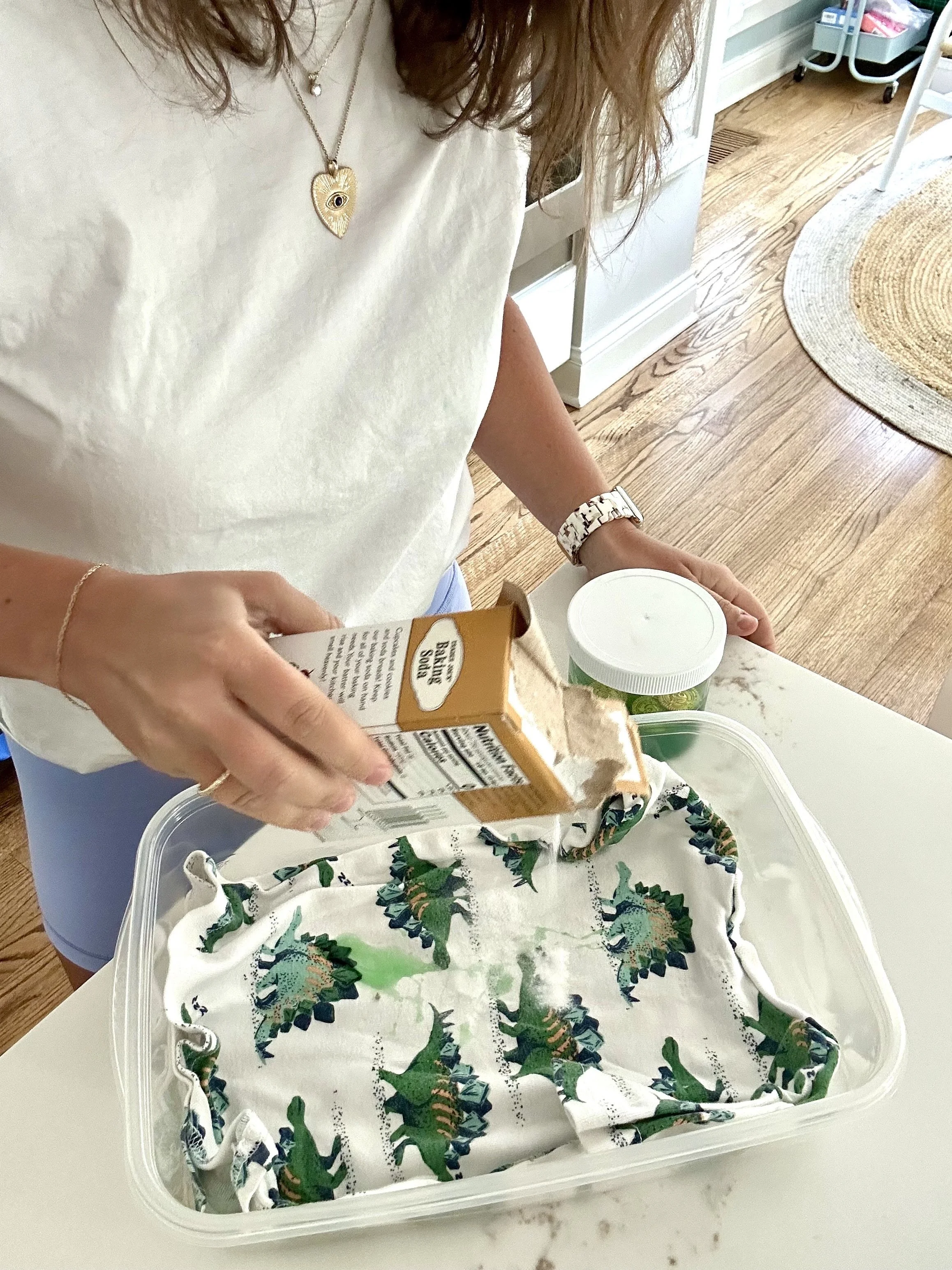How to Get Slime Out of Clothes (and Carpet!) Without Losing Your Mind
Slime is basically a kid’s dream, but for parents, it’s more like a recurring nightmare. One minute they’re happily crafting, and the next you’re staring at a mystery blob on their favorite sweatshirt or a dried-up patch stuck in the carpet. It doesn’t matter if it’s fresh and gooey or crusted over and forgotten—slime stains always seem to show up at the worst time.
The good news is that getting slime out of clothes and carpet isn’t impossible. You don’t need special products or a full-on meltdown. Just a little time and a few things you probably already have at home can go a long way. I’ve dealt with plenty of slime stains around here, from school uniforms to our Medley couch (full review here), and these are the methods that actually worked. So if you’re staring at a slime mess right now, take a breath.
Here’s how to clean it up before it gets any worse.
First things first, act fast and keep calm!
The faster you act, the better the slime removal outcome. Slime doesn’t wait, so neither should you.
Don’t rub. That just pushes the slime deeper into the fabric fibers or carpet.
Don’t use hot water. It can set the stain.
Don’t machine dry until it’s clean. Heat locks in remaining slime.
Scrape off as much slime as possible using a butter knife or spoon—especially if it’s wet slime. That’s your preliminary step.
What to Keep in Your Slime-Cleaning Kit
When slime hits the carpet or clothes, I usually reach for one of three things: hydrogen peroxide, white vinegar, or baking soda. They’ve saved me more times than I can count—especially when the mess has already dried. I rounded up the exact supplies I keep on hand in this list of favorites, in case it helps.
Grab whichever of these you have handy before you dive in:
White vinegar — great for breaking down slime, especially fresh or dried stains
Baking soda — pairs well with vinegar to fizz away tough residue
Cold water & warm water — cold helps prevent setting stains, warm helps rinse slime off
Liquid dish soap (like Dawn dish soap) — excellent for cutting through slime’s stickiness
Rubbing alcohol (isopropyl alcohol) — good for stubborn slime, but test on a hidden spot first
Hydrogen peroxide — useful for tough stains, especially on white or colorfast fabrics
Shaving cream — surprisingly effective at loosening dried slime (just don’t use on delicate fabrics)
Cotton ball — handy for applying liquids gently
Small bowl — for mixing cleaning solutions or pastes
Paper towel, clean towel, or soft cloth — for blotting and drying
Old toothbrush or soft-bristled brush — helps gently scrub slime without damaging fabric
Washing machine & liquid laundry detergent — to finish the job and get clothes fully clean
Slime Removal Supplies
Optional helpers (test first on a hidden area!):
Nail polish remover — use sparingly, can damage some fabrics
Lemon juice — natural stain fighter and deodorizer
Olive oil — can loosen sticky slime bits but might leave an oil stain if not washed properly
Lens solution — sometimes helps dissolve slime with borax-based recipes
Goo Gone — great for sticky residue, but test first to avoid damage
Masking tape — perfect for gently lifting slime bits without rubbing or spreading
Looking to Buy Some Slime? Here Are Some of My Favorites
If slime is still a big hit at your house (it definitely is at mine), it helps to have a few options on hand that are fun for kids and a little easier on the cleanup side.
Here are a few we’ve tried and liked:
Slime Kit with Tools & Glow-in-the-Dark Colors – Tons of variety and kept my kids busy for hours.
Butter Slime Pack – Super soft and not as sticky as some of the others out there.
Slime with Add-ins – My kid loves adding beads and glitter to this one.
Just... maybe bookmark this page too in case any of it ends up on your carpet.
How to Get Slime Out of Clothes
Method 1: White Vinegar
My favorite way to remove gooey slime from clothes.
Steps:
Pour vinegar directly onto the affected area.
Let sit for 5–10 minutes.
Scrub gently in a circular motion with an old toothbrush.
Rinse with cool water.
Toss in the washing machine with liquid laundry detergent.
Air dry and inspect. If any remaining slime is there, repeat.
This is one of the most effective ways to handle fresh messes from store-bought slime or homemade slime recipes.
Method 2: Baking Soda + Vinegar Combo
A fizzy powerhouse, perfect for stubborn stains and dried slime.
Steps:
Make a paste in a small bowl with baking soda + a few drops of water.
Spread it on the slime stain and let dry.
Scrape off hardened paste.
Dab with vinegar and scrub with a soft-bristled brush.
Rinse with warm water and machine wash.
Works well on slime made from a combination of glue and food coloring.
Method 3: Dawn Dish Soap & Water
One of the easiest ways to treat delicate items.
Steps:
Apply drops of dish soap (preferably Dawn dish soap) to the stain.
Rub with your fingers or a soft cloth.
Rinse with warm water.
Wash in the washing machine. Repeat if needed.
Ideal for delicate fabrics or light-colored items where vinegar might feel too intense.
Bonus Household Hacks:
Shaving cream: Rub onto the stain, let sit for 5–10 minutes, then rinse with cool water.
Nail polish remover: Use a cotton ball and spot test first—this works on very tough stains.
Olive oil: A good idea for hair or delicate items. Follow up with dish soap to remove oil residue.
Lemon juice + baking soda: Natural stain-lifting duo, especially on food-dyed slime.
Isopropyl alcohol: Melts away dried slime, especially good on synthetic fabrics.
Lens solution: Surprisingly helpful on slime with similar ingredients to contact-safe glue.
Sometimes you’ll need to try a couple of times—but each method has a good chance of working the first time with the right approach.
How to Get Slime Out of Carpet:
Step 1: Scrape or Freeze It
Use a blunt knife or credit card to remove excess slime. For dried slime, place ice cubes on it for 5–10 minutes until it hardens. Then crack it off.
Step 2: Choose Your Cleaning Solution
A. Vinegar Solution (For Fresh Slime)
Mix equal parts white vinegar and warm water in a spray bottle.
Add a few drops of dish soap.
Spray the affected area and let it sit.
Blot with a clean cloth or paper towel using a circular motion.
B. Baking Soda + Hydrogen Peroxide (For Stubborn Stains)
Sprinkle baking soda on the slime.
Spray with a mix of hydrogen peroxide + warm water.
Let fizz for 10 minutes.
Blot with a soft cloth or clean towel.
Great for carpet with delicate fabrics or tough stains from store-bought slime.
Step 3: Rinse + Dry
Rinse with cold water and blot dry.
Repeat spray + blot if needed.
Vacuum or fluff carpet after drying.
Pro tip: Use a pet carpet cleaner, steam cleaner, or portable carpet cleaner if you’ve got one.
Extra Tips for Tricky Spots
Club soda: Great for tackling food coloring stains thanks to its gentle fizz. Just blot, don’t rub, to avoid spreading the color.
Goo Gone: Perfect for cutting through glittery or oily slime stuck to surfaces. Be sure to test on a hidden area first to avoid any damage.
Olive oil: Works wonders loosening slime trapped in carpet loops. Follow up with dish soap to remove any leftover oil and prevent stains.
Lens solution: Handy for dissolving stubborn slime residue, especially if vinegar doesn’t do the trick. Use it sparingly and test on an inconspicuous spot first.
Prevention = Sanity
Let’s be honest—it’s only a matter of time before slime shows up again.
Tips:
Cover surfaces with a washable tablecloth to catch slime before it sticks.
Encourage kids to play with slime on easy-to-clean surfaces like a tray or plastic mat.
Have a dedicated slime bucket or container to keep slime contained and off your furniture.
Set up a small cleanup kit near your craft area with vinegar, towels, and dish soap for easy access.
Bonus: How to Get Slime Out of Hair
Slime in your kid’s hair? Yep, it’s a sticky situation that feels way worse than a gooey mess on clothes or carpet. But before you reach for a pair of scissors, take a deep breath—there are some easy ways to tackle slime stuck in your child’s hair (even if it’s long, curly, or fine human hair).
Step 1: Don’t Panic and Prep Your Supplies
You’ll want a bowl of warm water and some oil-based product like peanut butter, coconut oil, vegetable oil, or baby oil. These natural oils work wonders to loosen slime’s grip by breaking down the sticky stuff. Apple cider vinegar, a gentle weak acid, is another great option if oil isn’t doing the trick.
Step 2: Apply Your Chosen Oil-Based Product
Generously massage the peanut butter or oil into the affected hair strands and the bit of slime stuck there. Let it sit for 5–10 minutes. This natural method softens the slime, making it easier to remove.
Step 3: Use a Wide-Tooth or Fine-Tooth Comb
After the slime starts to loosen, use a wide-tooth comb for thick or curly hair and a fine-tooth comb for smaller chunks or finer hair. Slowly and gently work through the hair to remove pieces of slime without causing hair damage or breakage.
Step 4: Rinse and Condition
Rinse the hair thoroughly with warm running water (a hot shower helps). Then, apply a generous amount of hair conditioner to smooth out any remaining slime or oily residue. Use a wide-tooth comb again to detangle. Follow up with shampoo (normal shampoo is fine) to clean the hair completely.
Step 5: When Else Fails…
If you’re still dealing with stubborn slime—maybe that tricky non-sticky slime or even silly putty-like slime—try soaking the affected area of your child’s hair in a solution of vinegar and water, then comb it out. If all else fails, a dull knife can gently scrape away hardened chunks, but be careful to avoid cutting or damaging the hair or scalp.
FAQs
-
Yes, most fabrics respond well to the methods shared here. However, delicate or dry-clean-only fabrics may need special care. Always test cleaning solutions on a hidden spot first, and when in doubt, consult a professional cleaner.
-
Older stains can be tougher but not impossible. Try repeating the vinegar and baking soda methods, and don’t rush the process. For very stubborn stains, a spot treatment with rubbing alcohol or hydrogen peroxide might help.
-
If used correctly, these methods are safe for most everyday fabrics and carpets. Avoid hot water and machine drying until stains are fully gone, and always test harsher solutions like nail polish remover or Goo Gone on a small hidden area first.
-
Set clear boundaries for slime play—use washable tablecloths, trays, or plastic mats. Keep slime contained in a dedicated bucket or container, and have a cleanup kit ready nearby for quick action.
-
Yes! The vinegar, dish soap, and baking soda methods can work on upholstery and car seats. Be gentle when scrubbing and avoid soaking the material. Always test first and consider professional cleaning for sensitive or expensive fabrics.
-
No worries! Start with what you have—vinegar, dish soap, and baking soda are the most versatile. Many slime stains can be tackled with just these basics.
-
Machine washing helps remove slime residues but works best after you’ve pre-treated the stain by scraping and applying one of the recommended solutions. Avoid machine drying until you’re sure the stain is gone to prevent setting it permanently.
-
Use these products sparingly and only as a last resort. Both can be harsh and may damage or discolor fabrics. Always test on an inconspicuous area first, and rinse thoroughly after use.
-
Carpet fibers can trap slime deep down, making it tricky to clean. The best way is to gently scrape off excess slime, then use a vinegar-based spray or baking soda and hydrogen peroxide combo. Avoid harsh scrubbing to protect the carpet fibers. Always blot gently and finish by rinsing with cold water for best results.
-
Fresh slime is gooey and easier to remove by scraping and applying dish soap or vinegar solutions right away. Dry slime can be more stubborn and often requires soaking with baking soda paste, oil-based products, or shaving cream to soften the residue before gently combing or scrubbing it away.
-
Stubborn slime stains can feel like a daunting task, but patience and repeated treatment usually do the trick. Try alternating between vinegar and baking soda treatments, or apply rubbing alcohol carefully on the affected area. Let each treatment sit a bit before rinsing and repeating if necessary.
-
If you notice a sticky or slimy residue after cleaning, try gently blotting the area with a solution of diluted vinegar or use a small amount of dish soap mixed with warm water. Avoid rubbing hard, which can spread the residue or damage fabric and fibers.
Whether you're dealing with slime on a toddler's car seat or trying to rescue the rug in your favorite family vacation rental, the goal is the same: don’t panic.
Getting slime out usually takes a couple of tries. But with the right method, a bit of patience, and maybe even a sense of humor, you can save their favorite shirt and your rug without too much stress.
Have a slime tip that worked for you? Share it in the comments. Parenting gets messy, and we're all in this together.
















